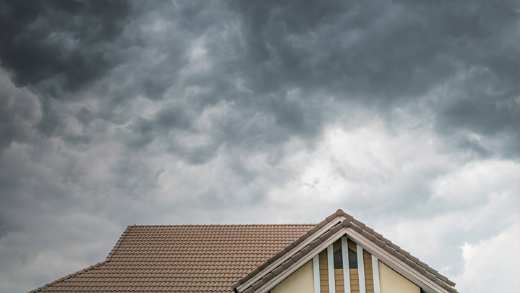Subsidence: everything you need to know

Got a sinking feeling there’s something wrong with your home? Find out what subsidence is, the tell-tale signs you shouldn’t ignore, and when and how to make an insurance claim.
By Emma Mitra
You thought your home was your perfect partner. The bright rooms, the convenient location, the interesting view. But in time, like any relationship, a few cracks started to appear. They were small and barely noticeable at first, but now they’re getting bigger and you’re wondering if your home really is quite so perfect after all, and if you might have a bit of a problem on your hands.
Stay calm – you might not need to break up with your home just yet. Cracked walls are fairly common in the UK, particularly in older properties. They could be a sign of subsidence, or nothing to worry about, but cracked walls are fixable.
The foundations of subsidence
Subsidence means that the ground beneath a building is moving or sinking downwards, with the potential to pull the foundations down too.
While the idea of dealing with it may sound daunting, if caught early enough subsidence can be managed with little intrusion.
Here’s what you need to know about subsidence and whether it’s covered by your home insurance.
What causes subsidence?
Subsidence can occur when soil loses moisture and shrinks, particularly during prolonged spells of hot, dry weather. So those heatwaves we’re having? Not great news when it comes to subsidence.
Statistics from the Association of British Insurers (ABI) Footnote [1] show that claims for subsidence are highest during summer months, particularly in 2018 when the UK experienced high temperatures. Contrast that to 2021, when the UK summer was much wetter, and claims for subsidence were lower.
Some varieties of tree can also take moisture from certain soil types, causing it to dry and shrink, while leaks from drains or water mains can be an issue by softening soil or washing it away, prompting downwards movement.
What to look for
Diagonal cracks on the inside and outside of your property extending to ground level are the most common sign that you might be dealing with subsidence. If you’ve spotted cracks like these, get in touch with your home insurer.
Cracks may simply be the result of wear and tear – as properties get older, it’s normal for them to move and settle over the years.
Other reasons a property might move include heave – when the ground beneath a building moves up, basically the opposite of subsidence – or landslide, when the ground under the property moves down a slope, taking the building with it.
Fixing subsidence

Aviva Home Insurance
With Aviva Home Insurance you can choose Buildings, Contents or both.
Caught early enough and subsidence can be managed, often with little disruption. Yes, you read that correctly: while mental images of diggers and exposed foundations may spring to mind at the mere mention of subsidence, it's estimated that fewer than 5% of properties suffering from subsidence need underpinning Footnote [2] (the process used to strengthen a building's foundations).
Even when underpinning is required, traditional concrete underpinning – where the depth of the foundations is increased by digging down and filling the spaces with concrete, essentially creating a new set of foundations – isn’t always necessary.
Resin injections are a much less invasive form of underpinning. The technique involves injecting resin into the foundations through small incisions made in the ground which then expands and compresses the soil, at the same time filling in any spaces.
The likelihood is that you won’t need to decide between either, because correcting drainage issues and removing trees are more common solutions.
Needless to say, it’s best to wait for an expert to investigate the issue, cause and likely solution rather than trying to fix it yourself, as you could ultimately do more harm than good.
How insurance can help (and what it won’t help with)
Fixing subsidence has the potential to get expensive, so it’s a good idea to have insurance in place. Most home insurance policies will cover a claim for subsidence, with a standard excess applicable.
At Aviva, we appoint a specialist company to manage subsidence insurance claims, from the initial investigations to the final repairs. They’ll establish the cause of damage, determine whether the damage is covered by your insurance, arrange investigations, and assess and approve repairs.
They’ll usually want to know the rough date the suspected subsidence appeared, along with photographs of any damage. If you’ve got an extension, conservatory or carried our building work, hold on to any documents relating to it, as they may want to see that too.
If it does turn out to be subsidence, your insurance will cover the costs for it to be fixed, along with the cost of repairing the damage caused by subsidence. Pre-existing damage, or damage not caused by subsidence, probably won’t be covered.
Making a subsidence claim
If you do see signs of subsidence, get in touch with your insurer asap. Getting the claims process underway early is critical, as it could result in the need for less intrusive work further down the line.
If you’re an Aviva customer, the fastest way to do this is by tapping into MyAviva.
Most subsidence claims take between six months to two years to resolve, but it depends on the cause of the subsidence and how complex it is. You’ll get an estimate of the claim duration at the outset.
The claims process will look something like this:
Investigate
There’ll be a survey of your property to investigate the cause of the damage.
Monitor
Sometimes a property will be monitored to check a building is stable before repairs start, or to establish if a particular tree is causing a problem.
Mitigate
The cause of the subsidence will be fixed.
Repair
Your insurers will fund the cost of repairing damage caused by subsidence identified as part of your claim.
So while subsidence is unlikely to be a welcome change in your relationship with your home, it certainly doesn’t need to be a dealbreaker. By understanding the signs, causes and having insurance in place, you can get back on with living happily ever after.








